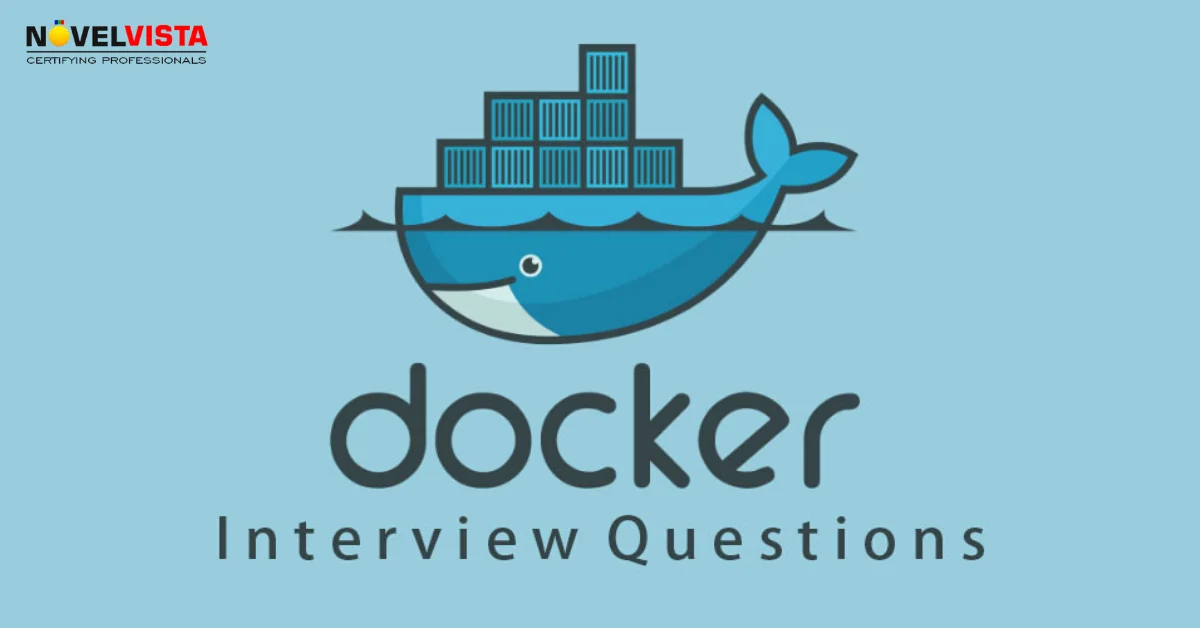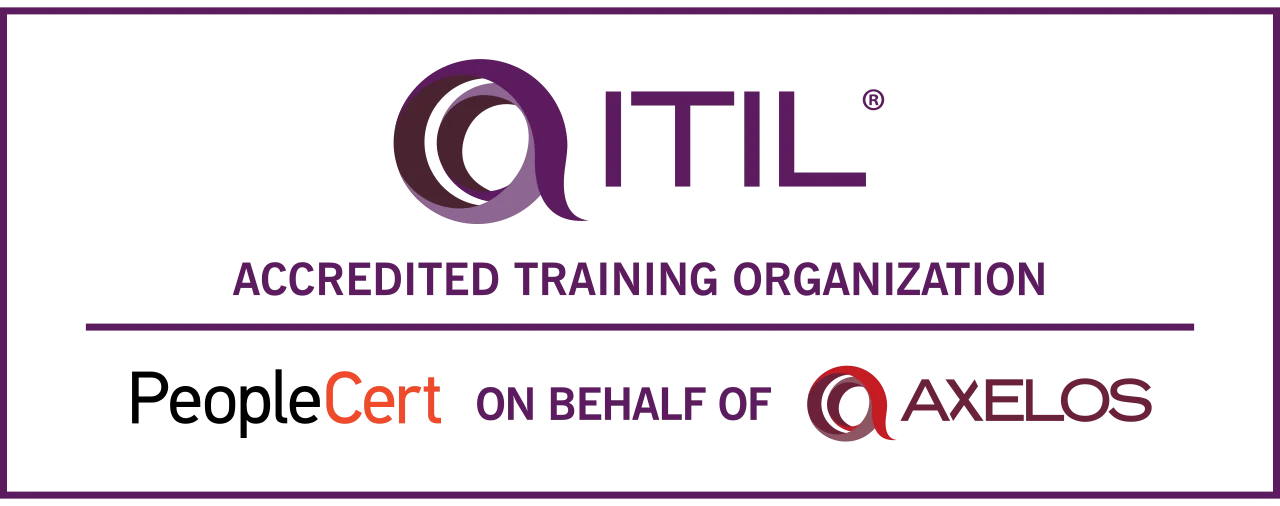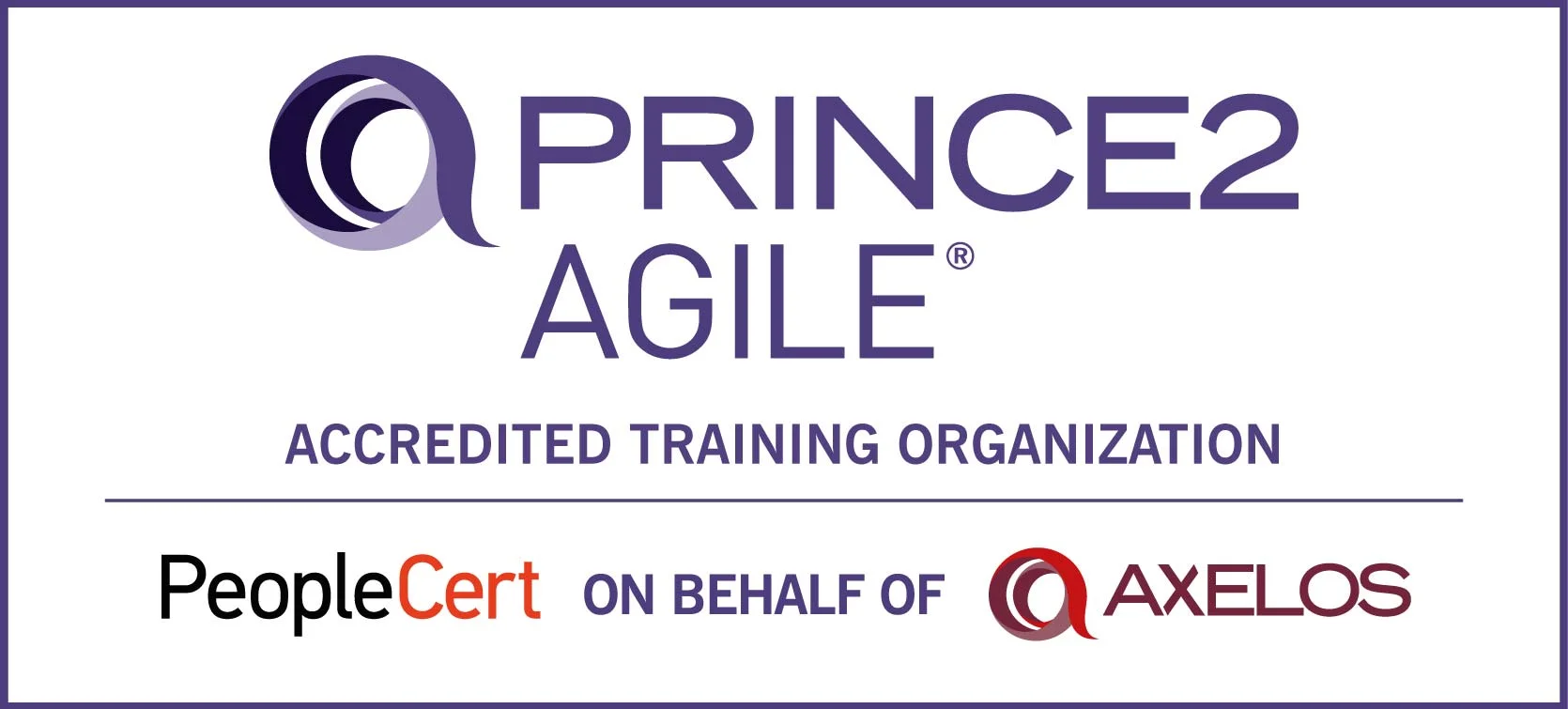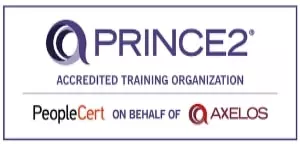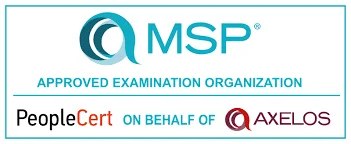Have a Scrum Master interview coming up? It's natural to be nervous. But worry not! We've got you covered.
Scrum has gained popularity and is being adopted by companies worldwide. As a result, there's an increased demand for Certified Agile Scrum Masters.
To help you ace your interview, we've compiled a list of the
Foundational Concepts
1. What is Scrum?
Ans. Scrum is a well-known Agile methodology that helps teams work together more effectively. It showcases collaboration, responsibility, and continuous improvement through repetitive development cycles called Sprints. Scrum breaks down complex projects into manageable parts, allowing teams to provide high-quality results more faster.
Quick Tip: Practice explaining Scrum in one minute. Clarity matters in interviews!
2. Differentiate Between Agile and Scrum.
Ans.
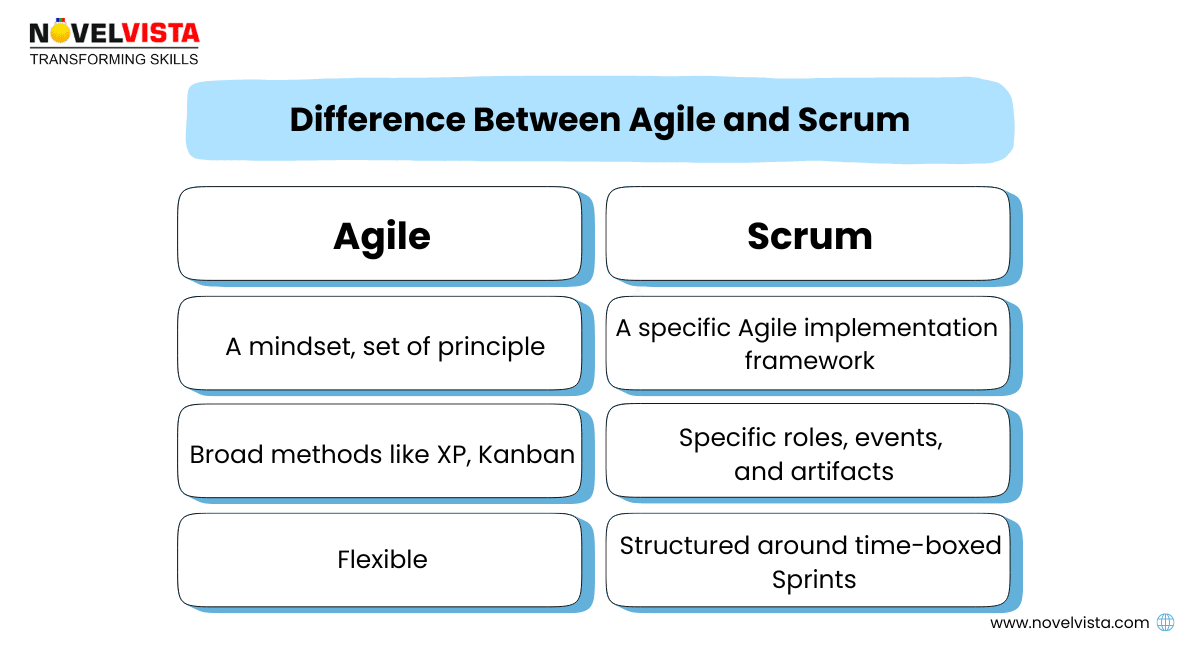
Scrum is a subset of Agile. In interviews, hope for follow-up questions like “Why do you choose Scrum over Kanban?”
3. What makes Scrum different from other Agile methods, and what is it exactly?
Ans: Scrum is an Agile framework that stands out due to its structured approach. It differs from other Agile methods through its core components. Scrum employs fixed-length iterations, called Sprints, for work delivery. It features a Product Owner who manages a prioritized Product Backlog, and self-organizing teams that take responsibility for their work, guided by a Scrum Master.
4. What are the three key pillars of Scrum, and how do they support Agile principles?
Ans: Scrum's three pillars underpin Agile values. Transparency ensures everyone involved has clear visibility into the project's status, promoting collaboration. Inspection involves frequent reviews of the work, aiding in early issue detection. Adaptation empowers teams to respond to evolving requirements, aligning with Agile's customer-centric focus. Together, these pillars bolster Agile principles in Scrum projects
5. What are the outcomes of the Scrum procedure?
Ans. There are three core outcomes in Scrum:
- Product Backlog: List of features, improvements, and bug fixes.
- Sprint Backlog: Items selected for the current Sprint, with tasks broken down.
- Increment: The usable end product developed during the Sprint.
Understanding these artifacts is vital because they promote transparency and alignment throughout the project lifecycle.
Scrum Roles and Responsibilities
6. Define the roles in Scrum.
Ans. Scrum has three specified roles:
- Product Owner: Manages the product backlog and guarantees that the team makes what delivers the most value.
- Scrum Master: Supports the process, removes blockers, and makes sure that the team follows Scrum values and principles.
- Scrum Team (Developers): Self-organizing group responsible for delivering the product increment during each Sprint.
Each role is essential for maintaining balance in the Scrum framework .
7. What are the responsibilities of the Scrum Team?
Ans. The Scrum team dedicates to delivering a product growth by the end of each Sprint. Responsibilities include:
- Participating in Sprint planning
- Breaking down work into tasks
- Calculating and completing work
- Attending daily stand-ups and reviews
- Guaranteeing quality and meeting the Definition of Done
A collaborative mindset is critical here. Be ready with a team success story!
8. Who is a Scrum Master? And what does he/she do?
Ans. A Scrum Master is a servant-leader for the team. Their responsibilities include:
- Supporting Scrum events
- Training the team on Agile practices
- Removing obstacles
- Safeguarding the team from external disturbance
They work closely with the Product Owner and the team to promote a high-performing, self-organizing environment.
Want to learn more? Check out Scrum Master Training & Certification .
9. Can you explain the roles and responsibilities of a Scrum Master?
Ans: The Scrum Master plays a vital role in a Scrum team. They facilitate Scrum events like Daily Standups and Sprint Reviews, ensuring they run smoothly. Their primary duty is to eliminate obstacles that hinder team progress, fostering a productive environment. Furthermore, Scrum Masters coach the team in Agile principles and practices, enabling continuous improvement.
10. What is the role of the Product Owner in Scrum, and how does the Scrum Master collaborate with them?
Ans: The Product Owner is a key role in Scrum responsible for defining and prioritizing the Product Backlog, which contains all the work items for the product. The Scrum Master collaborates closely with the Product Owner to ensure clear communication, alignment with the team's goals, and efficient backlog grooming. They work together to ensure that the development team understands the priority of work items and that the product development aligns with the overall vision and objectives set by the Product Owner.
11. What is the role of a Scrum Master in removing impediments for the development team?
Ans: The Scrum Master plays a critical role in identifying and helping to remove impediments that are blocking the team's progress. This often involves facilitating discussions, collaborating with stakeholders, and ensuring that the team can work without unnecessary disruptions.
12. How do you deal with team members who are resistant to adopting Scrum practices?
Ans: Handling resistance to Scrum practices involves open dialogue to address concerns and educate team members about the benefits of Scrum. Creating an environment that encourages experimentation and continuous improvement can help in overcoming resistance and fostering adoption.
13. How do you handle conflicts within the Scrum team?
Ans: Conflict resolution within a Scrum team involves fostering open communication and collaboration. The Scrum Master helps the team understand the source of conflicts and facilitates resolution through techniques like active listening and mediation. The goal is to address conflicts constructively and maintain a positive team dynamic.
14. How would you handle conflict within the team?
Ans. Handling conflict requires empathy, active listening, and neutrality. As a Scrum Master:
- Promote open conversations
- Increase mutual respect
- Focus on the root cause, not the symptoms
- Always look back for continuous improvement
Pro tip: Share a real example of how you solved a disagreement using facilitation skills.
15. How would you deal with a difficult stakeholder?
Ans. Stakeholder management is a main skill for Scrum Masters. Here’s how to handle it:
- Acknowledge their perspective
- Set expectations clearly
- Include them in reviews and planning
- Build up trust through clarity and periodic communication
Show that you can balance stakeholder needs without compromising the team’s focus.
Scrum Framework and Ceremonies
16. What is the Scrum Framework, and can you describe its various ceremonies?
Ans: The Scrum Framework is an approach to Agile project management. It comprises several ceremonies designed to ensure collaboration, transparency, and adaptability throughout a project. These events consist of Sprint Planning, Daily Scrum, Sprint Review, and Sprint Retrospective. Sprint Planning initiates a Sprint by selecting work from the Product Backlog. The Daily Scrum fosters daily synchronization and issue identification. Sprint Review involves stakeholders in inspecting the increment and gathering feedback. Sprint Retrospective focuses on team improvement, fostering a culture of continuous learning and adaptation.
17. Detailed Coverage of Scrum Events
Ans. Scrum events create a rhythm for the team and include:
- Sprint Planning: Define the Sprint goal and select backlog items.
- Daily Scrum: Coordinate daily work and identify obstacles.
- Sprint Review: Present what you have done and collect feedback.
- Sprint Retrospective: Represent team performance and identify improvements.
These events promote alignment and adaptability, and your ability to support them smoothly is always what interviewers look for.
17. How do you facilitate a Sprint Planning meeting?
Ans: In a Sprint Planning meeting, ensure collaboration among team members. The team collaboratively selects work from the Product Backlog, defines tasks, and estimates effort. It's crucial to set a clear Sprint goal, involve the whole team in decision-making, and ensure everyone understands their responsibilities to achieve the Sprint goal effectively.
18. What happens in Daily Stand-up sessions?
Ans. Also known as the Daily Scrum, this is a 15-minute meeting where team members discuss:
- What they did yesterday
- What they’ll do today
- Any problems or challenges
It improves communication, showcase dependencies, and boost responsibility. A well-run stand-up keeps momentum alive!
19. What is the purpose of a Daily Scrum (Daily Standup) meeting, and how do you facilitate it?
Ans: The Daily Scrum, often referred to as the Daily Standup, serves as a daily synchronization meeting for the Scrum team. Its primary purpose is to facilitate communication, identify impediments, and ensure everyone is aligned toward achieving the Sprint goal. To facilitate an effective Daily Scrum, it's essential to keep it short and time-boxed, usually to 15 minutes or less.
20. What is the purpose of a Sprint Review, and what activities are conducted during it?
Ans: The Sprint Review is a critical ceremony in Scrum, serving the purpose of inspecting the increment and gathering feedback from stakeholders. During a Sprint Review, the team presents a demo of the work completed during the Sprint, and stakeholders provide feedback. The meeting also includes a discussion of what should be done next, ensuring that the product development stays aligned with stakeholder expectations.
21. What is a Sprint Retrospective, and how do you conduct an effective retrospective meeting?
Ans: A Sprint Retrospective is a crucial ceremony in Scrum dedicated to team reflection and continuous improvement. Its purpose is to review the recent Sprint, identify what went well, and pinpoint areas for improvement. To conduct an effective retrospective, it's essential to create a safe and open environment where team members can openly share their insights. The meeting typically follows a structured format, including:
- Discussing what went well (positive aspects).
- Identifying areas for improvement (negative aspects).
- Collaboratively creating actionable items for the next Sprint to address these improvements. This process encourages the team to adapt and enhance their processes iteratively.
Scrum Artifacts and Key Concepts
23. Scrum Artifacts and Their Importance
Ans.
Artifacts ensure transparency and shared understanding:
- The Product Backlog communicates project vision.
- The Sprint Backlog traces Sprint progress.
- The Increment represents the output and value delivered.
Interviewers may ask you how you make sure visibility and updates across these results. Be ready with examples from past projects.
24. What is a Product Backlog, and how do you prioritize items within it?
Ans: The Product Backlog is a prioritized list of work items that drive product development. Prioritization factors include business value, customer feedback, and dependencies, ensuring that the most valuable and critical tasks are addressed first, aligning with the project's objectives.
25. Could you clarify what the term "Definition of Done" means?
Ans: The "Definition of Done" is a shared understanding of the criteria that must be met for a work item to be considered complete. It ensures that all deliverables meet the team's quality standards and are potentially shippable, aligning with the goal of delivering high-quality increments.
26. What is the definition of "Sprint" in Scrum, and how long should a Sprint typically last?
Ans: A Sprint is a time-boxed development cycle in Scrum, typically lasting between 2 to 4 weeks. This fixed timeframe provides predictability and allows the team to deliver a potentially shippable product increment at the end of each Sprint, enabling regular feedback and adaptation.
27. What are the benefits of using Story Points for estimating tasks in Scrum?
Ans: Story Points are a relative estimation technique used in Scrum to estimate the complexity of work items. The benefits include improved forecasting, better planning, and encouraging team discussions and consensus-building during the estimation process. Story Points help teams make more accurate predictions about the amount of work they can complete in a Sprint.
Team Performance and Agile Principles
28. How do you handle scope changes during a Sprint?
Ans: Scope changes during a Sprint should be minimized to maintain Sprint stability. If absolutely necessary, they should be discussed and approved by the Product Owner, with the entire team understanding the impact on the Sprint goal. This minimizes disruptions to the team's work.
29. How do you ensure that the Scrum team follows the Agile principles of continuous improvement (Inspect and Adapt)?
Ans: Ensuring that the Scrum team follows Agile principles involves fostering a culture of retrospection and continuous improvement. After each Sprint, the team conducts a retrospective where they reflect on their processes and performance. During this meeting, they collaboratively identify improvements and actionable items for the next Sprint, ensuring that the team adapts and evolves its practices to become more efficient and effective over time.
30. Can you explain the concept of "self-organizing teams" in Scrum?
Ans: Self-organizing teams in Scrum have the autonomy to make decisions about how to achieve their Sprint goals. This means that team members collectively decide how to plan and execute the work, including task assignments and problem-solving. The Scrum Master's role is to empower and support the team in making these decisions, fostering a sense of ownership and responsibility among team members.
31. How do you measure the success of a Scrum team?
Ans: The success of a Scrum team is measured by its ability to deliver a potentially shippable product increment at the end of each Sprint. Additionally, success is indicated by improvements in velocity (the amount of work completed in each Sprint) and enhanced product quality, demonstrating the team's capability to consistently deliver value.
32. Describe the difference between Velocity and Burndown charts, and how are they used in Scrum.
Ans: Velocity measures the team's capacity and productivity, providing insights into how much work the team can typically complete in a Sprint. In contrast, a Burndown chart tracks the remaining work in a Sprint, allowing the team to monitor daily progress and adjust their efforts accordingly. Velocity is useful for long-term planning, while the Burndown chart helps track and manage work during the Sprint.
Collaboration and Problem-Solving
33. How do you address the issue of a team member consistently failing to meet Sprint commitments?
Ans: Addressing a team member's consistent failure to meet Sprint commitments involves a systematic approach. It starts with private discussions to understand the underlying causes and challenges the team member is facing. If necessary, provide support or training to help them improve. If the issue persists and impacts the team's performance, involve the Product Owner and relevant stakeholders to collectively find a solution that ensures the team's commitment to the Sprint goal is met.
34. How do you handle situations where the team cannot complete all the committed work within a Sprint?
Ans: When the team cannot complete all the committed work within a Sprint, it's essential to address the situation effectively. Start by working with the team to analyze the reasons behind the incomplete work. Focus on delivering the highest-priority items and adjust the Sprint plan accordingly. Use the situation as a learning opportunity for the team to better understand their capacity and improve their Sprint planning and estimation processes.
35. How do you handle conflicts within the Scrum team?
Ans: Conflict resolution within a Scrum team involves fostering open communication and collaboration. The Scrum Master helps the team understand the source of conflicts and facilitates resolution through techniques like active listening and mediation. The goal is to address conflicts constructively and maintain a positive team dynamic.
36.Can you share a specific example of a challenging situation you encountered as a Scrum Master and how you resolved it?
Ans: Certainly, in one project, we faced frequent scope changes that disrupted our Sprints. To resolve this, I facilitated a meeting involving the Product Owner, stakeholders, and the development team. Together, we established a clear change request process that outlined how scope changes would be documented, assessed, and approved. This process helped maintain stability within the Sprints, improved communication, and allowed the team to better manage and adapt to changes while staying aligned with project goals. It showcased the importance of collaboration and effective process management in Agile projects.
37. Scrum Master's Evolving Role
Ans. In today’s Agile world, the Scrum Master’s role expands beyond coordination:
- They act as an Agile coach
- Make organizational change
- Guide multiple teams
- Support the Scrum master roadmap for increasing Agile practices
With organizations accepting Agile at scale, Scrum Masters are evolving into transformation agents. Stay one step ahead by getting certified. Explore the Benefits of Agile Scrum Master Certification.
Final Thoughts
Getting ready for scrum master interview questions isn’t just about memorizing answers—it's about showcasing how you apply Scrum values in real-world situations. If you're explaining the importance of Sprint Planning or showcasing how you train a struggling team, genuineness and clarity are main parts.
Need to upskill before your next big interview? Head over to Novelvista and explore hands-on certification programs to boost your confidence.
Ready to step up your Agile game?
Check out the full Scrum master roadmap and start preparing today!
Prepare with the Most Common and Critical Interview Questions
Author Details

Vaibhav Umarvaishya
Cloud Engineer | Solution Architect
As a Cloud Engineer and AWS Solutions Architect Associate at NovelVista, I specialized in designing and deploying scalable and fault-tolerant systems on AWS. My responsibilities included selecting suitable AWS services based on specific requirements, managing AWS costs, and implementing best practices for security. I also played a pivotal role in migrating complex applications to AWS and advising on architectural decisions to optimize cloud deployments.
Course Related To This blog
GSDC Agile
Confused About Certification?
Get Free Consultation Call





